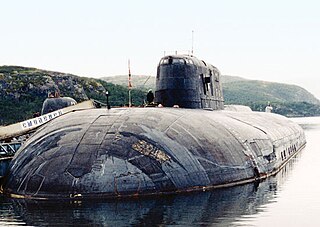
USS Kitty Hawk (CV-63), formerly CVA-63, was a United States Navy supercarrier. She was the second naval ship named after Kitty Hawk, North Carolina, the site of the Wright brothers' first powered airplane flight. Kitty Hawk was the first of the three Kitty Hawk-class aircraft carriers to be commissioned and the last to be decommissioned.

The Oscar class, Soviet designations Project 949 Granit and Project 949A Antey, are a series of nuclear-powered cruise missile submarines designed in the Soviet Union for the Soviet Navy. First built in the 1970s, six remain in service with the Russian Navy. Two other vessels were slated to be modernized since at least 2017 as Project 949AM, to extend their service life and increase combat capabilities but it is unclear whether work continues as of 2023.

A cruise missile submarine is a submarine that carries and launches cruise missiles as its primary armament. Missiles greatly enhance a warship's ability to attack surface combatants and strike land targets; although torpedoes are a more discreet option for submerged submarines, missiles give a much longer stand-off range, shorter time to impact the target, as well as the ability to engage multiple targets on different headings at the same time. Many cruise missile submarines retain the capability to deploy nuclear warheads on their missiles, but they are considered distinct from ballistic missile submarines due to the substantial differences between the two weapons systems' flight characteristics; cruise missiles fly aerodynamically using flight surfaces like wings or fins, while a ballistic missile uses its engine power alone as it may exit the atmosphere.

The Victor class, Soviet designations Project 671 Yorsh, Project 671RT Syomga and Project 671RTM/RTMK Shchuka,, are series of nuclear-powered attack submarines built in the Soviet Union and operated by the Soviet Navy. Since the 1960s, 48 units were built in total, of which the last remaining are currently in service with the Russian Navy. The Victor-class submarines featured a teardrop shape, allowing them to travel at high speed. These vessels were primarily designed to protect Soviet surface fleets and to attack American ballistic missile submarines. Project 671 began in 1959 with the design task assigned to SKB-143.

The Akula class, Soviet designation Project 971 Shchuka-B is a series of fourth generation nuclear-powered attack submarines (SSNs) first deployed by the Soviet Navy in 1986. There are four sub-classes or flights of Shchuka-B, consisting of the original seven Project 971 boats, commissioned between 1984 and 1990; six Project 971Is, commissioned between 1991 and 2009; one Project 971U, commissioned in 1995; and one Project 971M, commissioned in 2001. The Russians call all of the submarines Shchuka-B, regardless of modifications.
The Delta III-class submarine, Soviet designation Project 667BDR Kaľmar (Squid), is a large ballistic missile submarine operated by the Russian Navy. Like other previous Delta-class submarines, the Delta III class is a double hulled design, with a thin low magnetic steel outer hull wrapped around a thicker inner pressure hull.

The Sierra class, Soviet designations Project 945 Barrakuda and Project 945A Kondor,, are a series of nuclear-powered attack submarines intended for the Soviet Navy and currently in service with the Russian Navy.
B-414 Daniil Moskovsky was a Project 671RTM Schuka attack submarine of the Russian Northern Fleet. The submarine was laid down in 1989, launched and commissioned in 1990. It was known as K-414 before renaming in 1992. In 1994 B-414 took part in joint combat service with SSBN Karelia (K-18) of the Delta IV class. In 1996 the submarine was named after Prince Daniil Moskovsky, the youngest son of Alexander Nevsky.

The K-456 Tver, formerly known as K-456 Vilyuchinsk, is a Russian Oscar class SSGN of the Russian Navy. It was commissioned in 1991 as part of the Russian Northern Fleet and was transferred to the Russian Pacific Fleet in September 1993. The submarine is currently based at the Rybachiy Nuclear Submarine Base, in Vilyuchinsk, near Petropavlovsk-Kamchatsky. Until 28 January 2011 it was called Vilyuchinsk, when the name was changed to Tver.

K-266 Orel is a Project 949AM nuclear-powered cruise missile submarine (SSGN). She is one of three Oscar II submarines still serving in the Russian Northern Fleet, all assigned to the 11th Submarine Division, berthed at Guba Bolshaya Lopatka, on the Kola Peninsula northwest of Severomorsk.
The K-119 Voronezh is an Oscar-class submarine in the Russian Navy.

The K-150 Tomsk is an Oscar-class submarine in the Russian Navy.

The K-410 Smolensk is an Oscar-class submarine in the Russian Navy.
The K-132 Irkutsk is an Oscar-class submarine in the Russian Navy.

The K-317 Pantera is an Akula-class submarine in the Russian Navy.

The K-322 Kashalot was an Akula-class submarine in the Russian Navy.

The K-331 Magadan is an Akula-class submarine in the Russian Navy.
The K-391 Bratsk is an Akula-class submarine in the Russian Navy.
The K-480 Ak Bars is an Akula-class submarine in the Russian Navy.











